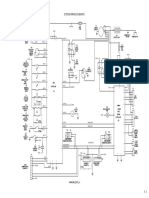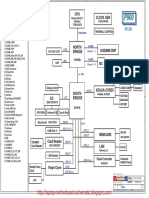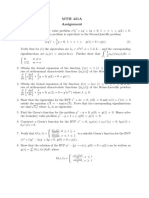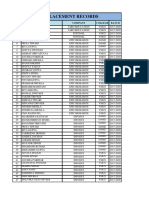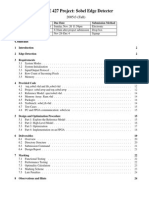Tle6250 v34 Can Bus
Tle6250 v34 Can Bus
Uploaded by
Ber HonzaCopyright:
Available Formats
Tle6250 v34 Can Bus
Tle6250 v34 Can Bus
Uploaded by
Ber HonzaCopyright
Available Formats
Share this document
Did you find this document useful?
Is this content inappropriate?
Copyright:
Available Formats
Tle6250 v34 Can Bus
Tle6250 v34 Can Bus
Uploaded by
Ber HonzaCopyright:
Available Formats
CAN-Transceiver TLE 6250
TLE 6250 V33
Final Data Sheet
Features
• CAN data transmission rate up to 1 MBaud
• Suitable for 12 V and 24 V applications
• Excellent EMC performance (very high immunity and
very low emission)
• Version for 5 V and 3.3 V micro controllers
• Bus pins are short circuit proof to ground and battery
voltage P-DSO-8-3
• Over-temperature protection
• Very wide temperature range (- 40°C up to 150°C)
Type Ordering Code Package
TLE 6250 G Q67006-A9427 P-DSO-8-3
TLE 6250 C Q67000-A9594 (chip)
TLE 6250 G V33 Q67006-A9523 P-DSO-8-3
TLE 6250 C V33 Q67000-A9538 (chip)
Description
The CAN-transceiver TLE 6250 is a monolithic integrated circuit that is available as bare
die as well as in a P-DSO-8-3 package. The IC is optimized for high speed differential
mode data transmission in automotive and industrial applications and is compatible to
ISO/DIS 11898 (see page 12 and 20). It works as an interface between the CAN protocol
controller and the physical differential bus in both, 12 V and 24 V systems.
Note:
There are two versions available: one for 5 V logic and the other one for 3.3 V logic
requiring additional supply via the V33V pin. The IC can be set to stand-by mode via an
control input. In addition the 5 V-version offers a receive only mode feature to support
diagnostic functions.
The IC is based on the Smart Power Technology SPT which allows bipolar and CMOS
control circuitry in accordance with DMOS power devices existing on the same
monolithic circuit. The TLE 6250 is designed to withstand the severe conditions of
automotive applications and provides excellent EMC performance.
Data Sheet Version 3.4 1 2002-10-08
TLE 6250
TLE 6250 V33
TxD 1 8 INH TxD 1 8 INH
GND 2 7 CANH GND 2 7 CANH
P-DSO-8-3 P-DSO-8-3
VCC 3 6 CANL VCC 3 6 CANL
RxD 4 5 RM RxD 4 5 V33V
TLE 6250 G TLE 6250 GV33
Figure 1 Pin Configuration (top view)
Pin Definitions and Functions
Pin No. Symbol Function
1 TxD CAN transmit data input; 20 kΩ pull up, LOW in dominant state
2 GND Ground;
3 VCC 5 V Supply;
4 RxD CAN receive data output; LOW in dominant state,
integrated pull up
5 RM Receive-only input; (5 V-version), 20 kΩ pull up, set low to
activate RxD-only mode
V33V Logic supply; (3.3 V-version) 3.3 V OR 5V microcontroller logic
supply can be connected here! The digital I/Os of the TLE6250V33
adopt to the connected microcontroller logic supply at V33V
6 CANL Low line input; LOW in dominant state
7 CANH High line output; HIGH in dominant state
8 INH Control input; 20 kΩ pull, set LOW for normal mode
Data Sheet Version 3.4 2 2002-10-08
TLE 6250
TLE 6250 V33
Functional Block Diagram
TLE 6250 G 3 V
CC
7
CANH Driver
Output 1
Temp.- TxD
6 Stage
CANL Protection
8
Mode Control INH
= 5
RM
Receiver
4
RxD
2
GND
AEB02922
Figure 2 Block Diagram TLE 6250 G
Data Sheet Version 3.4 3 2002-10-08
TLE 6250
TLE 6250 V33
TLE 6250 G V33 3 V
CC
5 V
3.3 V
7
CANH Driver
Output 1
Temp.- TxD
6 Stage
CANL Protection
8
Mode Control INH
=
Receiver
4
RxD
2
GND
AEB02923
Figure 3 Block Diagram TLE 6250 G V33
Data Sheet Version 3.4 4 2002-10-08
TLE 6250
TLE 6250 V33
Application Information
Normal Mode
INH = 1 RM = 0 Normal Mode
INH = 0 RM = 1
INH = 0 INH = 0
RM = 1
and RM = 1
INH=1 INH=0
INH = 0
and RM = 0
Stand-by Mode Receive-only Mode Stand-by
Mode
INH = 1
INH = 1 RM = 0 / 1 INH = 0 RM = 0
INH = 1
AED02924
5V Version 3.3V Version
Figure 4 Mode State Diagram
Both, the TLE 6250 G as well as the TLE 6250 C offer three different operation modes
(see Figure 4), controlled by the INH and RM pin for the TLE6250 and only by the INH
pin for the 6250 V33. In the normal mode the device is able to receive and to transmit
messages whereas in the receive-only mode signals at the TxD input are not transmitted
to the CAN bus. The receive-only mode can be used for diagnostic purposes as well as
to prevent the bus being blocked by a faulty permanent dominant TxD input signal. The
stand-by mode is a low power mode that disables both, the receiver as well as the
transmitter. For the TLE 6250 G V33 and TLE 6250 C V33 the receive only mode
feature is not available. The inhibit feature for this versions works in the same way as for
the 5V versions.
In case the receive-only feature is not used the RM pin has to be left open. When the
stand-by mode is not used the INH pin has to be connected to ground level in order to
switch the TLE 6250 in normal mode.
Data Sheet Version 3.4 5 2002-10-08
TLE 6250
Application Information for the 3.3V Version
The TLE 6250V33 can be used for both; 3.3V and 5V microcontroller logic supply as
shown below. Don´t apply external resistors between the power supply and this pin. This
may cause a voltage drop and so reduce the available voltage at this pin.
TLE 6250 G V33 TLE 6250 G V33
INH 8 INH 8
RxD 4 RxD 4
TxD 1 TxD 1
7 CANH 7 CANH
3.3V µP 5V
V33V 5 µP
V33V 5 6 CANL
6 CANL
GND VCC 3 GND GND VCC 3
GND
2 2
100 nF 100 nF
100 nF 100 nF 100 nF
VI VQ1 5V 5V
VI VQ
100 e.g. TLE 4476 100
nF
e.g. TLE 4270 22 µF
nF
VQ2 3.3V
GND GND
22 µF 22 µF
22 µF 22 µF
Application with 3.3V I/O supply Application with 5V I/O supply
Data Sheet Version 3.4 6 2002-10-08
TLE 6250
Electrical
Characteristics
TLE6250 G
(5V Version)
Data Sheet Version 3.4 7 2002-10-08
TLE 6250
Electrical Characteristics
Absolute Maximum Ratings
Parameter Symbol Limit Values Unit Remarks
min. max.
Voltages
Supply voltage VCC – 0.3 6.5 V –
CAN input voltage VCANH/L – 40 40 V –
(CANH, CANL)
Logic voltages at VI – 0.3 VCC V 0 V < VCC < 5.5 V
INH, RM, TxD, RxD
Electrostatic discharge VESD –6 6 kV human body model
voltage at CANH,CANL (100 pF via 1.5 kΩ)
Electrostatic discharge VESD –2 2 kV human body model
voltage (100 pF via 1.5 kΩ)
Temperatures
Junction temperature Tj – 40 160 °C –
Note: Maximum ratings are absolute ratings; exceeding any one of these values may
cause irreversible damage to the integrated circuit.
Data Sheet Version 3.4 8 2002-10-08
TLE 6250
Operating Range
Parameter Symbol Limit Values Unit Remarks
min. max.
Supply voltage VCC 4.5 5.5 V –
Junction temperature Tj – 40 150 °C –
Thermal Resistances
Junction ambient Rthj-a – 185 K/W –
Thermal Shutdown (junction temperature)
Thermal shutdown TjsD 160 200 °C 10 °C hysteresis
temperature
Data Sheet Version 3.4 9 2002-10-08
TLE 6250
Electrical Characteristics
4.5 V < VCC < 5.5 V; RL = 60 Ω; VINH < VINH,ON; – 40 °C < Tj < 150 °C; all voltages with
respect to ground; positive current flowing into pin; unless otherwise specified.
Parameter Symbol Limit Values Unit Remarks
min. typ. max.
Current Consumption
Current consumption ICC – 6 10 mA recessive state;
VTxD = VCC
Current consumption ICC – 45 70 mA dominant state;
VTxD = 0 V
Current consumption ICC – 6 10 mA receive-only mode;
RM = low
Current consumption ICC,stb – 1 10 µA stand-by mode;
TxD = RM = high
Receiver Output R×D
HIGH level output IRD,H – -4 -2 mA VRD = 0.8 × VCC,
current Vdiff < 0.4 Vnote 1)
LOW level output IRD,L 2 4 – mA VRD = 0.2 × VCC,
current Vdiff > 1 Vnote 1)
Transmission Input T×D
HIGH level input voltage VTD,H – 0.5× 0.7× V recessive state;
threshold VCC VCC
LOW level input voltage VTD,L 0.3× 0.4× – V dominant state
threshold VCC VCC
TxD pull up resistance RTD 10 25 50 kΩ –
note1) Vdiff = VCANH – VCANL
Data Sheet Version 3.4 10 2002-10-08
TLE 6250
Electrical Characteristics (cont’d)
4.5 V < VCC < 5.5 V; RL = 60 Ω; VINH < VINH,ON; – 40 °C < Tj < 150 °C; all voltages with
respect to ground; positive current flowing into pin; unless otherwise specified.
Parameter Symbol Limit Values Unit Remarks
min. typ. max.
Inhibit Input (pin INH)
HIGH level input voltage VINH,H – 0.5× 0.7× V stand-by mode;
threshold VCC VCC
LOW level input voltage VINH,L 0.3× 0.4× – V normal mode
threshold VCC VCC
INH pull up resistance RINH 10 25 50 kΩ –
Receive only Input (RM) (5V version only)
HIGH level input voltage VRM,H – 0.5× 0.7× V normal mode;
threshold VCC VCC
LOW level input voltage VRM,L 0.3× 0.4× – V receive-only mode
threshold VCC VCC
RM pull up resistance RRM 10 25 50 kΩ –
Data Sheet Version 3.4 11 2002-10-08
TLE 6250
Electrical Characteristics (cont’d)
4.5 V < VCC < 5.5 V; RL = 60 Ω; VINH < VINH,ON; – 40 °C < Tj < 150 °C; all voltages with
respect to ground; positive current flowing into pin; unless otherwise specified.
Parameter Symbol Limit Values Unit Remarks
min. typ. max.
Bus Receiver
Differential receiver Vdiff,d – 0.75 0.90 V – 20 V < (VCANH,
threshold voltage, VCANL) < 25 V
recessive to dominant Vdiff = VCANH – VCANL
edge
Differential receiver Vdiff,r 0.50 0.60 – V – 20 V < (VCANH,
threshold voltage VCANL) < 25 V
dominant to recessive Vdiff = VCANH – VCANL
edge
Common Mode Range CMR -20 – 25 V VCC = 5V
Differential receiver Vdiff,hys – 150 – mV –
hysteresis
CANH, CANL input Ri 10 20 30 kΩ recessive state
resistance
Differential input Rdiff 20 40 60 kΩ recessive state
resistance
Data Sheet Version 3.4 12 2002-10-08
TLE 6250
Electrical Characteristics (cont’d)
4.5 V < VCC < 5.5 V; RL = 60 Ω; VINH < VINH,ON; – 40 °C < Tj < 150 °C; all voltages with
respect to ground; positive current flowing into pin; unless otherwise specified.
Parameter Symbol Limit Values Unit Remarks
min. typ. max.
Bus Transmitter
CANL/CANH recessive VCANL/H 0.4 × – 0.6 × V VTxD = VCC
output voltage VCC VCC
CANH, CANL recessive Vdiff -1 – 0.05 V VTxD = VCC
output voltage difference
Vdiff = VCANH – VCANL
no load; (see note 2)
CANL dominant output VCANL – – 2.0 V VTxD = 0 V;
voltage VCC = 5 V
CANH dominant output VCANH 2.8 – – V VTxD = 0 V;
voltage VCC = 5 V
CANH, CANL dominant Vdiff 1.5 – 3.0 V VTxD = 0 V;
output voltage difference VCC = 5 V
Vdiff = VCANH – VCANL
CANL short circuit ICANLsc 50 120 200 mA VCANLshort = 18 V
current – 150 – mA VCANLshort = 36 V
CANH short circuit ICANHsc -200 -120 -50 mA VCANHshort = 0 V
current
CANH short circuit ICANHsc – -120 – mA VCANHshort = -5 V
current
Output current ICANH,lk -50 -300 -400 µA VCC = 0 V, VCANH =
VCANL = -7 V
-50 -100 -150 µA VCC = 0 V, VCANH =
VCANL = -2 V
Output current ICANH,lk 50 280 400 µA VCC = 0 V, VCANH =
VCANL = 7 V
50 100 150 µA VCC = 0 V, VCANH =
VCANL = 2 V
note 2) deviation from ISO/DIS 11898
Data Sheet Version 3.4 13 2002-10-08
TLE 6250 V33
Electrical Characteristics (cont’d)
4.5 V < VCC < 5.5 V; RL = 60 Ω; VINH < VINH,ON; – 40 °C < Tj < 150 °C; all voltages with
respect to ground; positive current flowing into pin; unless otherwise specified.
Parameter Symbol Limit Values Unit Remarks
min. typ. max.
Dynamic CAN-Transceiver Characteristics
Propagation delay td(L),TR – 150 280 ns CL = 47 pF;
TxD-to-RxD LOW RL = 60 Ω; VCC = 5 V;
(recessive to dominant) CRxD = 20 pF
Propagation delay td(H),TR – 150 280 ns CL = 47 pF;
TxD-to-RxD HIGH RL = 60 Ω; VCC = 5 V;
(dominant to recessive) CRxD = 20 pF
Propagation delay td(L),T – 100 140 ns CL = 47 pF;
TxD LOW to bus RL = 60 Ω; VCC = 5 V
dominant
Propagation delay td(H),T – 100 140 ns CL = 47 pF;
TxD HIGH to bus RL = 60 Ω; VCC = 5 V
recessive
Propagation delay td(L),R – 50 140 ns CL = 47 pF;
bus dominant to RxD RL = 60 Ω; VCC = 5 V;
LOW CRxD = 20 pF
Propagation delay td(H),R – 50 140 ns CL = 47 pF;
bus recessive to RxD RL = 60 Ω; VCC = 5 V;
HIGH CRxD = 20 pF
1)
Data Sheet Version 3.4 14 2002-10-08
TLE 6250 V33
Electrical
Characteristics
TLE6250 GV33
(3.3V Version)
Data Sheet Version 3.4 15 2002-10-08
TLE 6250 V33
Electrical Characteristics
Absolute Maximum Ratings
Parameter Symbol Limit Values Unit Remarks
min. max.
Voltages
Supply voltage VCC – 0.3 6.5 V –
3.3 V supply V33V – 0.3 5.5 V –
CAN input voltage VCANH/L – 40 40 V –
(CANH, CANL)
Logic voltages at VI – 0.3 VCC V 0 V < VCC < 5.5 V
INH, RM, TxD, RxD
Electrostatic discharge VESD –6 6 kV human body model
voltage at CANH,CANL (100 pF via 1.5 kΩ)
Electrostatic discharge VESD –2 2 kV human body model
voltage (100 pF via 1.5 kΩ)
Temperatures
Junction temperature Tj – 40 160 °C –
Note: Maximum ratings are absolute ratings; exceeding any one of these values may
cause irreversible damage to the integrated circuit.
Data Sheet Version 3.4 16 2002-10-08
TLE 6250 V33
Operating Range
Parameter Symbol Limit Values Unit Remarks
min. max.
Supply voltage VCC 4.5 5.5 V –
3.3 V supply voltage V33V 3.0 5.5 V –
Junction temperature Tj – 40 150 °C –
Thermal Resistances
Junction ambient Rthj-a – 185 K/W –
Thermal Shutdown (junction temperature)
Thermal shutdown TjsD 160 200 °C 10 °C hysteresis
temperature
Data Sheet Version 3.4 17 2002-10-08
TLE 6250 V33
Electrical Characteristics
4.5 V < VCC < 5.5 V; (3.0 V < V33V < 3.6 V for 3.3 V version); RL = 60 Ω; VINH < VINH,ON;
– 40 °C < Tj < 150 °C; all voltages with respect to ground; positive current flowing into
pin; unless otherwise specified.
Parameter Symbol Limit Values Unit Remarks
min. typ. max.
Current Consumption (3.3V version)
Current consumption ICC+33V – 6 10 mA recessive state;
VTxD = V33V
Current consumption ICC+33V – 45 70 mA dominant state;
VTxD = 0 V
Current consumption I33V – – 2 mA
Current consumption ICC+33V,stb – 1 10 µA stand-by mode
TxD = high
Receiver Output R×D
HIGH level output IRD,H – -2 -1 mA VRD = 0.8 × V33V,
current Vdiff < 0.4 Vnote 1)
LOW level output current IRD,L 1 2 – mA VRD = 0.2 × V33V,
Vdiff > 1 Vnote 1)
Transmission Input T×D
HIGH level input voltage VTD,H – 0.55× 0.7× V recessive state;
threshold V33V V33V
LOW level input voltage VTD,L 0.3× 0.45× – V dominant state;
threshold V33V V33V
TxD pull up resistance RTD 10 25 50 kΩ –
note1) Vdiff = VCANH – VCANL
Data Sheet Version 3.4 18 2002-10-08
TLE 6250 V33
Electrical Characteristics (cont’d)
4.5 V < VCC < 5.5 V; (3.0 V < V33V < 3.6 V for 3.3 V version); RL = 60 Ω; VINH < VINH,ON;
– 40 °C < Tj < 150 °C; all voltages with respect to ground; positive current flowing into
pin; unless otherwise specified.
Parameter Symbol Limit Values Unit Remarks
min. typ. max.
Inhibit Input (pin INH)
HIGH level input voltage VINH,H – 0.55× 0.7× V stand-by mode;
threshold V33V V33V
LOW level input voltage VINH,L 0.3× 0.45× – V normal mode;
threshold V33V V33V
INH pull up resistance RINH 10 25 50 kΩ –
Data Sheet Version 3.4 19 2002-10-08
TLE 6250 V33
Electrical Characteristics (cont’d)
4.5 V < VCC < 5.5 V; (3.0 V < V33V < 3.6 V for 3.3 V version); RL = 60 Ω; VINH < VINH,ON;
– 40 °C < Tj < 150 °C; all voltages with respect to ground; positive current flowing into
pin; unless otherwise specified.
Parameter Symbol Limit Values Unit Remarks
min. typ. max.
Bus Receiver
Differential receiver Vdiff,d – 0.75 0.90 V – 20 V < (VCANH,
threshold voltage, VCANL) < 25 V
recessive to dominant Vdiff = VCANH – VCANL
edge
Differential receiver Vdiff,r 0.50 0.60 – V – 20 V < (VCANH,
threshold voltage VCANL) < 25 V
dominant to recessive Vdiff = VCANH – VCANL
edge
Common Mode Range CMR -20 – 25 V VCC = 5V
Differential receiver Vdiff,hys – 150 – mV –
hysteresis
CANH, CANL input Ri 10 20 30 kΩ recessive state
resistance
Differential input Rdiff 20 40 60 kΩ recessive state
resistance
Data Sheet Version 3.4 20 2002-10-08
TLE 6250 V33
Electrical Characteristics (cont’d)
4.5 V < VCC < 5.5 V; (3.0 V < V33V < 3.6 V for 3.3 V version); RL = 60 Ω; VINH < VINH,ON;
– 40 °C < Tj < 150 °C; all voltages with respect to ground; positive current flowing into
pin; unless otherwise specified.
Parameter Symbol Limit Values Unit Remarks
min. typ. max.
Bus Transmitter
CANL/CANH recessive VCANL/H 0.4 × – 0.6 × V VTxD = V33V
output voltage VCC VCC
CANH, CANL recessive Vdiff -1 – 0.05 V VTxD = V33V
output voltage difference
Vdiff = VCANH – VCANL
no load; (see note 2)
CANL dominant output VCANL – – 2.0 V VTxD = 0 V;
voltage VCC = 5 V
CANH dominant output VCANH 2.8 – – V VTxD = 0 V;
voltage VCC = 5 V
CANH, CANL dominant Vdiff 1.5 – 3.0 V VTxD = 0 V;
output voltage difference VCC = 5 V
Vdiff = VCANH – VCANL
CANL short circuit ICANLsc 50 120 200 mA VCANLshort = 18 V
current – 150 – mA VCANLshort = 36 V
CANH short circuit ICANHsc -200 -120 -50 mA VCANHshort = 0 V
current
CANH short circuit ICANHsc – -120 – mA VCANHshort = -5 V
current
Output current ICANH,lk -50 -300 -400 µA VCC = 0 V, VCANH =
VCANL = -7 V
-50 -100 -150 µA VCC = 0 V, VCANH =
VCANL = -2 V
Output current ICANH,lk 50 280 300 µA VCC = 0 V, VCANH =
VCANL = 7 V
50 100 150 µA VCC = 0 V, VCANH =
VCANL = 2 V
note 2) deviation from ISO/DIS 11898
Data Sheet Version 3.4 21 2002-10-08
TLE 6250
TLE 6250 V33
Electrical Characteristics (cont’d)
4.5 V < VCC < 5.5 V; (3.0 V < V33V < 3.6 V for 3.3 V version); RL = 60 Ω; VINH < VINH,ON;
– 40 °C < Tj < 150 °C; all voltages with respect to ground; positive current flowing into
pin; unless otherwise specified.
Parameter Symbol Limit Values Unit Remarks
min. typ. max.
Dynamic CAN-Transceiver Characteristics
Propagation delay td(L),TR – 150 280 ns CL = 47 pF;
TxD-to-RxD LOW RL = 60 Ω; VCC = 5 V;
(recessive to dominant) CRxD = 20 pF
Propagation delay td(H),TR – 150 280 ns CL = 47 pF;
TxD-to-RxD HIGH RL = 60 Ω; VCC = 5 V;
(dominant to recessive) CRxD = 20 pF
Propagation delay td(L),T – 100 140 ns CL = 47 pF;
TxD LOW to bus RL = 60 Ω; VCC = 5 V
dominant
Propagation delay td(H),T – 100 140 ns CL = 47 pF;
TxD HIGH to bus RL = 60 Ω; VCC = 5 V
recessive
Propagation delay td(L),R – 50 140 ns CL = 47 pF;
bus dominant to RxD RL = 60 Ω; VCC = 5 V;
LOW CRxD = 20 pF
Propagation delay td(H),R – 50 140 ns CL = 47 pF;
bus recessive to RxD RL = 60 Ω; VCC = 5 V;
HIGH CRxD = 20 pF
Data Sheet Version 3.4 22 2002-10-08
TLE 6250
TLE 6250 V33
Diagrams
8 8
INH INH
7 1 7 1
CANH TxD CANH TxD
5 4
47 pF 60 Ω RM 47 pF 60 Ω RxD
20 pF
6 4 6
CANL RxD CANL V3.3V 5 3.3 V
20 pF 100 nF
VCC 3 5V
VCC 3 5V
GND GND
100 nF 100 nF
2 2
AES02925
5V Version 3.3V Version
Figure 5 Test Circuits for Dynamic Characteristics
Data Sheet Version 3.4 23 2002-10-08
TLE 6250
TLE 6250 V33
VTxD
VCC(33V)
GND
VDIFF td(L), T td(H), T t
VDIFF(d)
VDIFF(r)
VRxD t
td(L), R td(H), R
VCC(33V)
0.7VCC(33V)
0.3VCC(33V)
GND
td(L), TR td(H), TR t
AET02926
Figure 6 Timing Diagrams for Dynamic Characteristics
Data Sheet Version 3.4 24 2002-10-08
TLE 6250
TLE 6250 V33
Application
120 Ω
TLE 6250 G
VBat 5
CAN RM
Bus 8
INH
7 4
CANH RxD µP
6 1
CANL TxD
VCC 3
GND GND
2 100 nF 100 nF
VI VQ 5V
e.g. TLE 4270
GND
22 µF 100 nF 22 µF
ECU 1
TLE 6250 G V33
8
INH
4
RxD
7 1
CANH TxD µP
6 V3.3 V 5
CANL
100 nF 100 nF
VCC
GND GND
2 100 nF
VI VQ1 5V
e.g. TLE 4476
VQ2 3.3 V
GND
22 µF 100 nF 22 µF 22 µF
120 Ω
ECU X
AES02927
Figure 7 Application Circuit
Data Sheet Version 3.4 25 2002-10-08
TLE 6250
TLE 6250 V33
Package Outlines
P-DSO-8-3
(Plastic Dual Small Outline Package)
GPS09032
Sorts of Packing
Package outlines for tubes, trays etc. are contained in our
Data Book “Package Information”
SMD = Surface Mounted Device Dimensions in mm
Data Sheet Version 3.4 26 2002-10-08
TLE 6250
TLE 6250 V33
Edition 2002-10-08
Published by Infineon Technologies AG,
St.-Martin-Strasse 53,
D-81541 München, Germany
© Infineon Technologies AG 2002.
All Rights Reserved.
Attention please!
The information herein is given to describe
certain components and shall not be consid-
ered as warranted characteristics.
Terms of delivery and rights to technical
change reserved.
We hereby disclaim any and all warranties,
including but not limited to warranties of
non-infringement, regarding circuits, descrip-
tions and charts stated herein.
Infineon Technologies is an approved CECC
manufacturer.
Information
For further information on technology, deliv-
ery terms and conditions and prices please
contact your nearest Infineon Technologies
Office in Germany or our Infineon Technolo-
gies Representatives worldwide (see ad-
dress list).
Warnings
Due to technical requirements components
may contain dangerous substances. For in-
formation on the types in question please
contact your nearest Infineon Technologies
Office.
Infineon Technologies Components may only
be used in life-support devices or systems
with the express written approval of Infineon
Technologies, if a failure of such components
can reasonably be expected to cause the fail-
ure of that life-support device or system, or to
affect the safety or effectiveness of that de-
vice or system. Life support devices or sys-
tems are intended to be implanted in the hu-
man body, or to support and/or maintain and
sustain and/or protect human life. If they fail, it
is reasonable to assume that the health of the
user or other persons may be endangered.
Data Sheet Version 3.4 27 2002-10-08
This datasheet has been download from:
www.datasheetcatalog.com
Datasheets for electronics components.
You might also like
- 30 Ecm Chevy c2 Motor Sfi 1.6 L.Document50 pages30 Ecm Chevy c2 Motor Sfi 1.6 L.Ber Honza100% (16)
- ECM Gran Vitara V6 H25Document2 pagesECM Gran Vitara V6 H25Ber Honza100% (4)
- Engine Control (5Vz-Fe) : System OutlineDocument10 pagesEngine Control (5Vz-Fe) : System OutlineBer Honza100% (4)
- Bosch m7.9.7 PDFDocument25 pagesBosch m7.9.7 PDFRuben Dario Casique83% (24)
- Case 621 ServiceDocument129 pagesCase 621 ServiceBer Honza40% (5)
- Montero ABSDocument136 pagesMontero ABSBer HonzaNo ratings yet
- Wiring Diagram: E1 - Engine Control UnitDocument3 pagesWiring Diagram: E1 - Engine Control UnitJez Pulis100% (1)
- 5V - Stb(为单12V预留): ControlDocument13 pages5V - Stb(为单12V预留): Controlyiyus1No ratings yet
- ABS Sentra 07Document2 pagesABS Sentra 07Josué0% (1)
- ESSTECH About JitterDocument21 pagesESSTECH About JitterjmcyangNo ratings yet
- Jeep Compass 2007 2.4 Circuito de ArranqueDocument1 pageJeep Compass 2007 2.4 Circuito de ArranqueBer Honza100% (1)
- Pdf - схема Электрооборудования HdDocument149 pagesPdf - схема Электрооборудования HdGiapy Phuc Tran100% (8)
- Hs Can: Automotive and IndustrialDocument41 pagesHs Can: Automotive and IndustrialJhonny Eduardo Suarez GretaNo ratings yet
- ECU 2.4L 2 de 3Document2 pagesECU 2.4L 2 de 3anzony francoNo ratings yet
- PDFDocument5 pagesPDFJohn Mark CorralesNo ratings yet
- Программирование ECU-Holden-OpelDocument17 pagesПрограммирование ECU-Holden-OpelDima DovgheiNo ratings yet
- ECM Power Source CircuitDocument4 pagesECM Power Source CircuitErln LimaNo ratings yet
- 2azfe 12 PDFDocument20 pages2azfe 12 PDFmasakpNo ratings yet
- Schematic P260 220 PDFDocument10 pagesSchematic P260 220 PDFFelipe Infante LeónNo ratings yet
- What Are The Pinout and Pin Functions of The Openport 2.0Document2 pagesWhat Are The Pinout and Pin Functions of The Openport 2.0spalomosNo ratings yet
- Pinout Tables FN2Document6 pagesPinout Tables FN2surajNo ratings yet
- Microsquirt IObox 1Document21 pagesMicrosquirt IObox 1jesus roblesNo ratings yet
- Toyota Flasher Quick Start GuideDocument4 pagesToyota Flasher Quick Start GuideVishal Vishal VishalNo ratings yet
- Complete List of Supported Vehicles - Systems in FiatECUScan 2.6.1. Adapter Cables - Interfaces - SUPPORTED VEHICLES - SYSTEMSDocument50 pagesComplete List of Supported Vehicles - Systems in FiatECUScan 2.6.1. Adapter Cables - Interfaces - SUPPORTED VEHICLES - SYSTEMSBruno CrespoNo ratings yet
- Megane3 D70F3424Document1 pageMegane3 D70F3424Feeze WdsNo ratings yet
- Datasheet MOSFET 2N60Document2 pagesDatasheet MOSFET 2N60Alvina Victorina Lopes GomesNo ratings yet
- C1 Tipm WK 2012Document2 pagesC1 Tipm WK 2012EBER OCHOANo ratings yet
- Immobiliser Emulator Daewoo 2Document10 pagesImmobiliser Emulator Daewoo 2Andres Felipe CespedesNo ratings yet
- Psa Modules Wiring Diagrams: Obd2 DB9Document9 pagesPsa Modules Wiring Diagrams: Obd2 DB9nianglemzoNo ratings yet
- Automotive Electronics Product Information Ignition Driver With Diagnosis - CK200Document5 pagesAutomotive Electronics Product Information Ignition Driver With Diagnosis - CK200ORLANDO HERRERANo ratings yet
- Datasheet f1010Document8 pagesDatasheet f1010shobu21100% (1)
- 2222Document5 pages2222Octavio RamosNo ratings yet
- 54 LAND CRUISER Station Wagon: Engine Immobiliser System (W/o Entry & Start System)Document1 page54 LAND CRUISER Station Wagon: Engine Immobiliser System (W/o Entry & Start System)Wawan SatiawanNo ratings yet
- 75 CC 88Document7 pages75 CC 88Briliant ImronNo ratings yet
- DatasheetDocument50 pagesDatasheetLuis BarbosaNo ratings yet
- Delphi 2.5Document1 pageDelphi 2.5Ashraf AliNo ratings yet
- M35160 Ug Rev 3Document19 pagesM35160 Ug Rev 3FreezzbyNo ratings yet
- Engine Assembly PulldownDocument22 pagesEngine Assembly PulldownDwight SolinaNo ratings yet
- DTC P0135 Oxyge (A/F) Sensor Heater Circuit (Bank 1 Sensor 1)Document3 pagesDTC P0135 Oxyge (A/F) Sensor Heater Circuit (Bank 1 Sensor 1)Erln Lima100% (1)
- DTC C1249/49 Open in Stop Light Switch Circuit: DescriptionDocument4 pagesDTC C1249/49 Open in Stop Light Switch Circuit: DescriptionAmil AnAmNo ratings yet
- AP3213211 TriCore AUDO F Bootloader PDFDocument40 pagesAP3213211 TriCore AUDO F Bootloader PDFFiliberto Conde MayoNo ratings yet
- Asus Eee PC p900 PDFDocument47 pagesAsus Eee PC p900 PDFRamdas KambleNo ratings yet
- ChipsDocument3 pagesChipsTony AlecsaNo ratings yet
- CY310 Product InfoDocument2 pagesCY310 Product InfoAnonymous xTGQYFrNo ratings yet
- (TM) Chery Manual de Motor Chery Arauca 2010 en InglesDocument89 pages(TM) Chery Manual de Motor Chery Arauca 2010 en Inglesjoseph_ds94No ratings yet
- Avr Isp Usb AioDocument1 pageAvr Isp Usb Aiospy004100% (1)
- Wistron Strongbow - KBL - MB 17863-1 r1Document106 pagesWistron Strongbow - KBL - MB 17863-1 r1Royer ArteagaNo ratings yet
- Service Manual: Car Navigation SystemDocument54 pagesService Manual: Car Navigation Systemjmolina666No ratings yet
- Obdprog mt401 Pro Mileage Correction ToolDocument14 pagesObdprog mt401 Pro Mileage Correction ToolKamal SurenNo ratings yet
- Electrical Equipment: Engine Compartment Connection UnitDocument106 pagesElectrical Equipment: Engine Compartment Connection UnitAlejandro ArangurenNo ratings yet
- Tms374 Ecu Decoder Manual PDFDocument10 pagesTms374 Ecu Decoder Manual PDFOcta DosNo ratings yet
- NT Kefico Cpgdsh2.2x.x Irom Tc1782 Kia Hyundai 1033Document4 pagesNT Kefico Cpgdsh2.2x.x Irom Tc1782 Kia Hyundai 1033Mohamed FoxNo ratings yet
- Starting - Charging - Toyota Corolla Le 2011 - System Wiring DiagramsDocument6 pagesStarting - Charging - Toyota Corolla Le 2011 - System Wiring Diagramsaliajordan41No ratings yet
- MSS65 - BDMDocument1 pageMSS65 - BDMNick Speis100% (2)
- Iaw15p UmDocument5 pagesIaw15p Umneoporsche15No ratings yet
- 7C13 10 PDFDocument48 pages7C13 10 PDFdavid pintoNo ratings yet
- 2012 04 BonettiDocument81 pages2012 04 Bonettihansraj4u4800No ratings yet
- ST10F275Document18 pagesST10F275Noel100% (1)
- Basic Concepts in Serial I/O Interfacing I/O DevicesDocument33 pagesBasic Concepts in Serial I/O Interfacing I/O DevicessubendNo ratings yet
- MST 9000 Auto Signal Operation StepsDocument11 pagesMST 9000 Auto Signal Operation Stepsjalvarez_385073100% (1)
- Specifications: PartsDocument1 pageSpecifications: PartsSameh ElmahdyNo ratings yet
- Terminal Alignment of ECM Coupler: 1A-6 Engine General Information and DiagnosisDocument1 pageTerminal Alignment of ECM Coupler: 1A-6 Engine General Information and DiagnosislombardiacmNo ratings yet
- BMW M5 Sedan Automatic, 7-SpeedDocument1 pageBMW M5 Sedan Automatic, 7-SpeedArik YeganyanNo ratings yet
- Caja Fusible KiaDocument4 pagesCaja Fusible KiaAndrésNo ratings yet
- MP - Multiplex CommunicationDocument61 pagesMP - Multiplex CommunicationWilly NozatoNo ratings yet
- TLE 6251 G: High Speed CAN-Transceiver With Wake DetectionDocument32 pagesTLE 6251 G: High Speed CAN-Transceiver With Wake DetectionDragos CezarNo ratings yet
- A82C250Document20 pagesA82C250AdamNo ratings yet
- Two-Wire Serial EEPROM: FeaturesDocument28 pagesTwo-Wire Serial EEPROM: FeaturesThế TùngNo ratings yet
- Terminals of Ecu: 1. Radio Receiver AssyDocument1 pageTerminals of Ecu: 1. Radio Receiver AssyBer HonzaNo ratings yet
- Suzuki Gran Vitara RH 2001 Gestion MotorDocument5 pagesSuzuki Gran Vitara RH 2001 Gestion MotorBer HonzaNo ratings yet
- tm1606 TXTX178649Document10 pagestm1606 TXTX178649Ber HonzaNo ratings yet
- Coolant Level Indicator On The 104, Samba, 205, 305, 504, 505 and 604 (SB - 1984 - XX - My84 - n31)Document1 pageCoolant Level Indicator On The 104, Samba, 205, 305, 504, 505 and 604 (SB - 1984 - XX - My84 - n31)Ber HonzaNo ratings yet
- Transmission Diagnostic Trouble Codes-Limp Home Mode and Inchless Power ShiftDocument2 pagesTransmission Diagnostic Trouble Codes-Limp Home Mode and Inchless Power ShiftBer HonzaNo ratings yet
- VolvoDocument5 pagesVolvoBer HonzaNo ratings yet
- Transmission Diagnostic Trouble Codes F301-F308 PDFDocument4 pagesTransmission Diagnostic Trouble Codes F301-F308 PDFBer HonzaNo ratings yet
- Service Manual: EQ1030T47D-820 Light Commercial TruckDocument175 pagesService Manual: EQ1030T47D-820 Light Commercial TruckYonny ColqueNo ratings yet
- S and S International 2016Document112 pagesS and S International 2016Ber HonzaNo ratings yet
- Sumo Gold ManualDocument114 pagesSumo Gold ManualBer HonzaNo ratings yet
- Osb CHK - PhoneSW PDFDocument10 pagesOsb CHK - PhoneSW PDFusmanNo ratings yet
- Micro-2407 User Must ReadDocument124 pagesMicro-2407 User Must ReadShyam SundarNo ratings yet
- Updater ScriptDocument3 pagesUpdater ScriptAmit YadavNo ratings yet
- TELEMAC Code InstructionsDocument3 pagesTELEMAC Code Instructionskim lee pooNo ratings yet
- 1.3.1.7 Lab - Build A Specialized Computer System PDFDocument5 pages1.3.1.7 Lab - Build A Specialized Computer System PDFantoci_stelianaNo ratings yet
- C FaqDocument116 pagesC FaqaskbilladdmicrosoftNo ratings yet
- AssignDocument1 pageAssignRAJESH KUMARNo ratings yet
- MM TAXBRA Migracao BatchDocument3 pagesMM TAXBRA Migracao BatchMárcio NascimentoNo ratings yet
- Truck Loadout: SystemsDocument3 pagesTruck Loadout: SystemsRamaswamyNo ratings yet
- Bca Placement Records: S No. Name Company College BatchDocument27 pagesBca Placement Records: S No. Name Company College BatchSarthak SinghNo ratings yet
- UNIT-5: GSM System Operations (Traffic Cases)Document16 pagesUNIT-5: GSM System Operations (Traffic Cases)Peter AugustineNo ratings yet
- Manufacturing EssentialsDocument675 pagesManufacturing EssentialsManuelHerediaHeredia100% (1)
- LMP BT Keypad FaqDocument2 pagesLMP BT Keypad FaqAnusawn ChirpongseNo ratings yet
- BCC Proxy AdminDocument356 pagesBCC Proxy AdminRajesh ChamanthulaNo ratings yet
- Sobel Edge Detector Using VHDL - ReportDocument25 pagesSobel Edge Detector Using VHDL - ReportRahul Agarwal0% (1)
- AsddasDocument34 pagesAsddasIndra HedarNo ratings yet
- STM32 Microcontroller Debug Toolbox PDFDocument99 pagesSTM32 Microcontroller Debug Toolbox PDFHồ Chí NhânNo ratings yet
- An Introduction To Fuzzy Sets Analysis and DesignDocument6 pagesAn Introduction To Fuzzy Sets Analysis and DesignIlyas DZNo ratings yet
- User Manual: Project Magenta Manual V20 Revision: 18 January-2013Document131 pagesUser Manual: Project Magenta Manual V20 Revision: 18 January-2013autocadplease6213No ratings yet
- Var 1Document22 pagesVar 1Margareta CINo ratings yet
- Change Log For YiiDocument46 pagesChange Log For YiiAnteTomasNo ratings yet
- SCM - Deep Dive Cost PlanningDocument19 pagesSCM - Deep Dive Cost PlanningSrinivasa Rao AsuruNo ratings yet
- RST 2602 PDFDocument48 pagesRST 2602 PDFhulikul22No ratings yet
- Description Logic IntroductionDocument27 pagesDescription Logic IntroductionImranNo ratings yet
- OracleDocument163 pagesOraclemousumiinderNo ratings yet
- Boolean Logic Mustafa Çağın ÖztorunDocument7 pagesBoolean Logic Mustafa Çağın Öztorunmustafacagino2026No ratings yet
- Arch Linux For DummiesDocument28 pagesArch Linux For DummiestotosttsNo ratings yet
- Day-2 Aggregate FunctionsDocument25 pagesDay-2 Aggregate FunctionsAshok DuraiNo ratings yet
- Maruti Suzuki ERPDocument32 pagesMaruti Suzuki ERPShray Jali100% (1)
- Stereomorph 3D Tutorial: How To Collect 3D Points and Curves Using A Stereo Camera SetupDocument67 pagesStereomorph 3D Tutorial: How To Collect 3D Points and Curves Using A Stereo Camera SetupInes Apituley SopacuaNo ratings yet


















